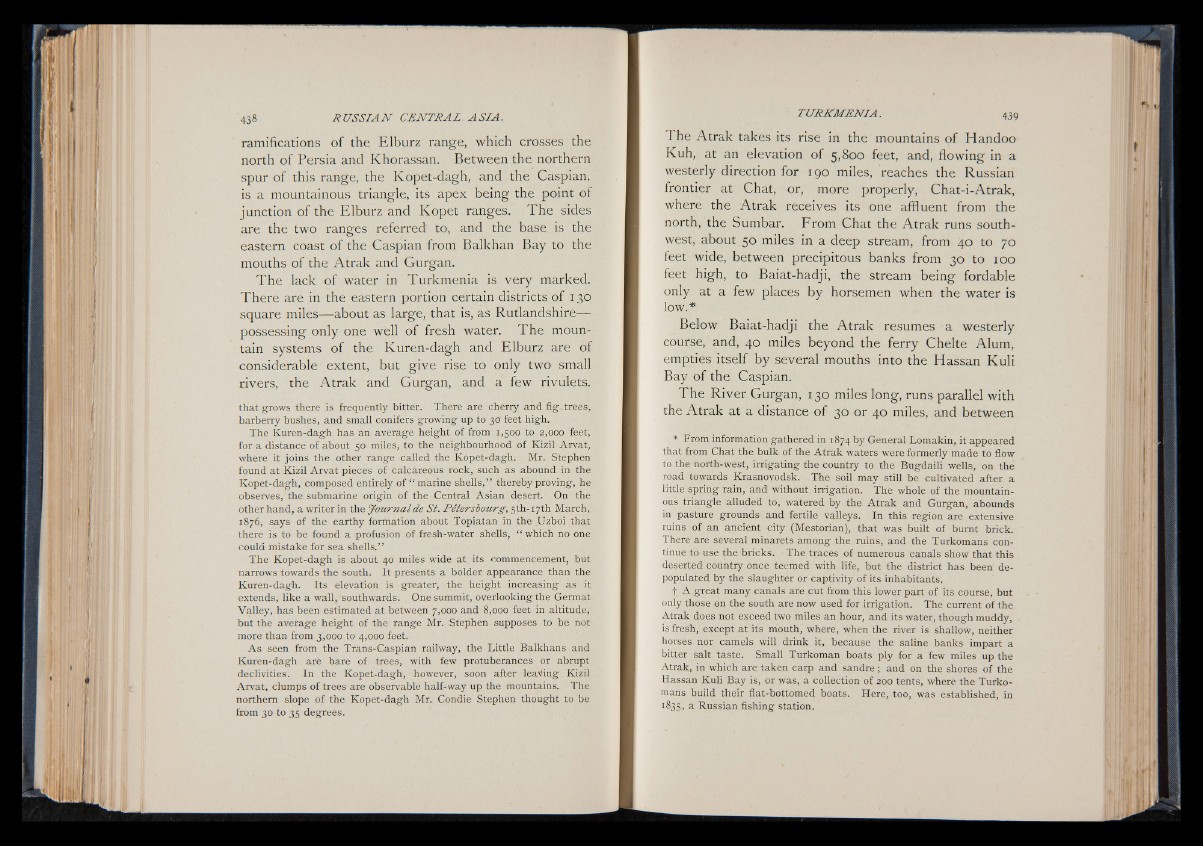
ramifications of the Elburz range, which crosses the
north of Persia and Khorassan. Between the northern
spur of this range, the Kopet-dagh, and the Caspian,
is a mountainous triangle, its apex being the point of
junction of the Elburz and Kopet ranges. The sides
are the two ranges referred' to, and the base is the
eastern coast of the Caspian from Balkhan Bay to the
mouths of the Atrak and Gurgan.
The lack of water in Turkmenia is very marked.
There are in the eastern portion certain districts of 130
square miles— about as large, that is, as Rutlandshire—
possessing only one well of fresh water. The mountain
systems of the Kuren-dagh and Elburz are of
considerable extent, but give rise to only two small
rivers, the Atrak and Gurgan, and a few rivulets.
that grows there is frequently bitter. There are cherry and fig-trees,
barberry bushes, and small conifers growing up to 30 feet high.
The Kuren-dagh has an average height of from 1,500 to 2,000 feet,
for a distance of about 50 miles, to the neighbourhood of Kizil Arvat,
where it joins the other range called the Kopet-dagh. Mr. Stephen
found at Kizil Arvat pieces of calcareous rock, such as abound in the
Kopet-dagh, composed entirely of “ marine shells,” thereby proving, he
observes, the submarine origin of the Central Asian desert. On the
other hand, a writer in the Journalde St. Petersbourg, 5th- 17th March,
1876, says of the earthy formation about Topiatan in the .Uzboi that
there is to be found a profusion of fresh-water shells, “ which no one
could mistake for sea shells.”
The Kopet-dagh is about 40 miles wide at. its commencement, but
narrows towards the south. It presents a bolder appearance than the
Kuren-dagh. Its elevation. is ' greater, the height increasing as it
extends, like a wall, southwards. One summit, overlooking the Germat
Valley, has been estimated at between 7,000 and 8,000 feet in altitude,
but the average height of the range Mr. Stephen supposes to be not
more than from 3,000 to 4,000 feet.
As seen from the Trans-Caspian railway, the Little Balkhans and
Kuren-dagh are bare of trees, with few protuberances or abrupt
declivities. In the Kopet-dagh, however, soon after leading Kizil
Arvat, clumps of trees are observable half-way up the mountains. The
northern slope of the Kopet-dagh Mr. Condie Stephen thought to be
from 30 to 35 degrees.
The Atrak takes its rise in the mountains of Handoo
Kuh, at an elevation of 5,800 feet, and, flowing in a
westerly direction for 190 miles, reaches the Russian
frontier at Chat, or, more properly, Chat-i-Atrak,
where the Atrak receives its one affluent from the
north, the Sumbar. From Chat the Atrak runs southwest,
about 50 miles in a deep stream, from 40 to 70
feet wide, between precipitous banks from 30 to 100
feet high, to Baiat-hadji, the stream being fordable
only at a few places by horsemen when the water is
low.*
Below Baiat-hadji the Atrak resumes a westerly
course, and, 40 miles beyond the ferry Chelte Alum,
empties itself by several mouths into the Hassan Kuli
Bay of the Caspian.
The River Gurgan, 130 miles long, runs parallel with
the Atrak at a distance o f 30 or 40 miles, and between
* From information gathered in 1874 by General Lomakin, it appeared
that from Chat the bulk of the Atrak waters were formerly made to flow
to the north-west, irrigating the country to the Bugdaili wells, on the
road towards Krasnovodsk. The soil may still be cultivated after a
little spring rain, and without irrigation. The whole of the mountainous
triangle alluded to, watered by the Atrak and Gurgan, abounds
in pasture grounds and fertile valleys. In this region are extensive
ruins of an ancient city (Mestorian), that was built of burnt brick.
There are several minarets amopg the ruins, and the Turkomans continue
to use the bricks. The traces of numerous canals show that this
deserted country once teemed with life, but the district has been depopulated
by the slaughter or captivity of its inhabitants,
j; A great many canals are cut from this lower part of its course, but
only those on the south are now used for irrigation. The current of the
Atrak does not exceed two miles an hour, and its water, though muddy,
is fresh, except at its mouth, where, when the river is shallow, neither
horses nor camels will drink it, because the saline banks impart a
bitter salt taste. Small Turkoman boats ply for a few miles up the
Atrak, in which are taken carp and sandre; and on the shores of the
Hassan Kuli Bay is, or was, a collection of 200 tents, where the Turkomans
build their flat-bottomed boats. Here, too, was established, in
1835, a Russian fishing station.